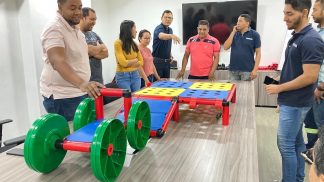Why gamifying your training isn’t good enough
Part two of a two-part series about gamification in education. Check out part one here: An introduction to gamification in education: miracle methodology, or just another buzzword?
As we saw in part one of this series, gamification can have some utility in boosting engagement and encouraging behaviours. But the methodology is limited in what it can achieve as a standalone concept.
In the context of education and training, gamification has two main downfalls:
- Game mechanics can too easily distract from core learning outcomes
- By training the learner’s brains for a dopamine hit when they carry out a desired action, gamification can reinforce undesirable behaviours.
If you’re a facilitator looking for ways to make your training more engaging and impactful, this post will explore ways to make meaningful improvements that achieve the outcomes gamification claims to deliver.
The limitations of gamification
To better understand the limitations of gamification in education, let’s look at an example.
Duolingo, the popular language learning app, makes great use of the methodology: there are leaderboards, learning pathways with progression bars, badges and awards, competitions with other learners, cooperation with other learners, and many more engaging dynamics.
And it’s hard to dispute that gamification keeps Duolingo’s user base motivated – just look at their engagement over time:
(Source)
But spend time in the app, and you’ll notice that it’s actually possible to rack up more experience repeating minigames that don’t teach you anything new than by completing lessons. And that fixating on the top spot on a leaderboard encourages you to exploit this method, further distracting you from your main goal of learning a language.
In this situation you’re not developing yourself or your target skill set. You’re not reflecting or developing yourself holistically: instead, you’re just learning and repeating a very precise skill.
You are more likely to be opening the app every day to practise, though. Because you’re getting used to the dopamine hit.
Gamification and experiential learning
While these two terms are sometimes used interchangeably, they are very different methodologies.
In our view, gamification is most valuable when it acts as a vehicle to learning techniques that have inherent utility. But because these techniques can be identified and leveraged without gamification, we recommend skipping the middleman entirely.
Experiential learning is a methodology that emphasises hands-on experience as the primary means of acquiring knowledge and skills. By putting learners in situations where they can use and experiment with different behaviours, then exploring these behaviours through individual and group review, experiential learning paves the way for lasting learning.
It’s also a vehicle through which all of gamification’s benefits can be accessed.
How game mechanics can improve your training
In part one of this series we explored 13 popular game mechanics that are often used in gamification. Here we will give actionable tips and activity recommendations for facilitators who want to access the benefits within the context of experiential learning.
1. Windows of enhanced attention
What it is: Alternating intervals of higher challenge and cognitive involvement with ones that are less intense.
Tips for facilitators: When planning training, don’t expect participants to learn at a consistent rate: instead, make allowances for varying levels of attention as a way to improve overall engagement. We recommend structuring training sessions accordingly, using breaks and activities with different levels of intensity to cater for varying levels of attention.
2. Progression dynamic
What it is: Gradual development of skill and ability as the game progresses.
Tips for facilitators: Within activities, you can make use of incremental, visible progress to boost motivation, with incrementally more challenging objectives that align with skill progression.
Part of experiential learning is structured review, which provides a valuable opportunity after each activity to discuss performance, highlight progress made, and identify potential goals for ongoing progress.
3. Long and short term goals
What it is: Overarching long-term goals supplemented by shorter-term ones; or, long-term goals split into shorter chunks.
Tips for facilitators: Use clearly defined long-term goals to guide learners towards their core objectives, and either split these into short-term goals to facilitate progression, or accompany them with alternate, optional short-term goals that learners can choose to focus on.
Chain Reaction is an experiential activity where long and short term goals with competing incentives are present, inviting participants to consider their strategic value and discuss optimal approaches for achieving the best combination of both. It’s available on MTa Immersion – our online experiential learning program.
4. Ranks, achievements and badges
What it is: Hierarchical recognition of progression and completion of goals.
Tips for facilitators: Although it sounds like a great motivator, we’d actually recommend not focussing on this in too much detail as it distracts from the experiential process!
5. Leaderboards
What it is: A visual depiction of players’ relative performance and rankings within the hierarchy.
Tips for facilitators: There are some activities where leaderboards can function well in an experiential context – like Disc Roll from MTa Insights, where competing teams score points by setting themselves and achieving targets – but as a general rule we’d echo the advice from above: using leaderboards as intended in the context of gamification can distract from the experiential methodology.
6. Increasing levels of challenge
What it is: Tasks become more difficult as players progress, to keep the level of challenge consistently engaging.
Tip for facilitators: Opening a session with a simple activity to ease people in and moving onto complex activities later is a good way to structure sessions. We also recommend activities like Leading the Team – also from MTa Insights, where participants must complete 3 quick-fire tasks of increasing complexity – as a way to explore which behaviours appear when challenge increases.
7. Immediate feedback
What it is: Instant responses to players’ actions to give immediate feedback on their performance.
Tips for facilitators: Linking consequence to action allows learning, and the experiential methodology relies on structured review as a way to gather and build upon feedback. By discussing performance with peers and consciously trying different behaviours, participants get immediate feedback. The Culprit is a great experiential learning activity where participants gain feedback through their own analysis and through that of their peers.
The Culprit is available on MTa Immersion – our online experiential learning program.
8. Social interaction
What it is: The ability to interface with other players, either directly in the game world or through an external communications layer like game chat.
Tips for facilitation: We recommend using activities with different configurations: working with partners, within small teams, within big teams, and so on. This gives participants the opportunity to experience varied dynamics and explore their behaviour in each. Kits like MTa Insights or MTa Team Kit offer plenty of choice.
9. Communal discovery and problem solving
What it is: A mechanic that leverages social interaction to encourage players to explore and solve problems collectively.
Tips for facilitators: As with social interaction, many experiential activities provide opportunities for this. Group review sessions are ideal incubators for communal discovery, and working through behaviours perceived as problematic with the view of identifying a solution. Learning via discussion with your peers what your strengths and weaknesses are is an empowering process, leading to real change.
10. Compelling narrative
What it is: A captivating narrative structure to guide progress and help players invest in their character.
Tips for facilitators: Activities like KanDo Lean or The Culprit leverage narrative storytelling to put learning within an engaging and relatable context.
11. Time pressure
What it is: A mechanic that introduces urgency and potentially increases the level of challenge as a result.
Tips for facilitators: This dynamic is pervasive in experiential learning activities: participants are often up against clock in meeting expectations, with Promises, Promises from MTa MINI being a great example: participants under pressure have a tendency to over commit and under deliver, and the ramifications are explored in detail.
12. Scarcity
What it is: A mechanic whereby resources or opportunities are limited, adding another vector for competition between players.
Tips for facilitators: Activities like Minefield and Water Tower both force creative use of resources and explore behaviours that arise from this pressure – both are part of MTa Insights.
Find out how an MTa kit can really improve your training
Our range of experiential learning kits features over 100 activities designed to develop an extensive array of learning outcomes, from broad skills like problem solving and leadership through to the granular skills needed to really unlock a participant’s full potential.
Rather than rely on buzzwords and fads like gamification, we’ve designed and refined each activity to make meaningful and impactful learning possible. Each activity gives participants the opportunity to gain concrete experience, reflect upon their behaviour, conceptualise improvements, and experiment with these newly identified alternatives. The result is lasting change that stays with the learner for life, rather than being forgotten once they leave the training room.
If you’re a facilitator looking to improve your training, talk to one of our experiential learning experts today. We’ll show you how to move beyond buzzwords and deliver engaging training that leads to lifelong learning.

